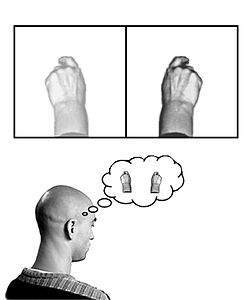Mirror Therapy

A mirror box is a box with two mirrors in the center (one facing each way), invented by Vilayanur S. Ramachandran to help alleviate Phantom limb Pain, in which patients feel they still have a limb after having it amputated.
Based on the observation that phantom limb patients were much more likely to report paralyzed and painful phantoms if the actual limb had been paralyzed prior to Amputation (for example, due to a brachial plexus avulsion), Ramachandran and Rogers-Ramachandran proposed the "learned paralysis" hypothesis of painful phantom limbs Template:Harv. Their hypothesis was that every time the patient attempted to move the paralyzed limb, they received sensory feedback (through vision and Proprioception) that the limb did not move. This feedback stamped itself into the brain circuitry through a process of Hebbian learning, so that, even when the limb was no longer present, the brain had learned that the limb (and subsequent phantom) was paralyzed.
To retrain the brain, and thereby eliminate the learned paralysis, Ramachandran and Rogers-Ramachandran Template:Harv created the mirror box. The patient places the good limb into one side, and the stump into the other. The patient then looks into the mirror on the side with good limb and makes "mirror symmetric" movements, as a symphony conductor might, or as we do when we clap our hands. Because the subject is seeing the reflected image of the good hand moving, it appears as if the phantom limb is also moving. Through the use of this artificial visual feedback it becomes possible for the patient to "move" the phantom limb, and to unclench it from potentially painful positions.
In 1999 V.S. Ramachandran and Eric Altschuler published the results of pilot studies on the use of mirrors in the treatment of hemispatial neglect (the inability to see or pay attention to one side of observed space) Template:Harv and hemiparesis after stoke (muscular weakness on one side of the body).Template:Harv Ramachandran and Altschuler concluded that mirror therapy may be useful in the treatment of these conditions.
Effectiveness[edit | edit source]
Although the use of mirror therapy has been shown to be effective in some cases there is still no widely accepted theory of how it works. In a 2010 study of phantom limb pain, Martin Diers and his colleagues found that "In a randomized, controlled trial that used graded motor imagery...and mirror training, patients with complex regional pain syndrome or phantom limb pain showed a decrease in pain as well as an improvement in function post-treatment and at the 6-month follow-up. And it was shown that the order of treatment mattered." However, this study found that mirrored imagery produced no significant cortical activity in patients with phantom limb pain and concluded that "The optimal method to alter pain and brain representation, and the brain mechanisms underlying the effects [of] mirror training or motor imagery, are still unclear." Template:Harv
A number of small scale research studies have shown encouraging results, however there is no current consensus as to the effectiveness of mirror therapy. Recent reviews of the published research literature by Moseley Template:Harv and Ezendam Template:Harv concluded that much of the evidence supporting mirror therapy is anecdotal or comes from studies that had weak methodological quality. In 2011 a large scale review of the literature on mirror therapy by Rothgangel Template:Harv summarized the current research as follows:
In 2011 Melita Giummarra and Lorimer Moseley published an article on phantom limb pain that summarized current approaches to treating this problem. They concluded that the benefits of mirror therapy appear to be limited to patients who suffer from cramping and muscular-type phantom pain. They stated:
Stroke[edit | edit source]
Mirror therapy (MT) has been employed with some success in treating stroke patients. Clinical studies that have combined mirror therapy with conventional rehabilitation have achieved the most positive outcomes. [1] However there is no clear consensus as to its effectiveness. In a recent survey of the published research Rothgangel concluded that "In stroke patients, we found a moderate quality of evidence that MT as an additional therapy improves recovery of arm function after stroke. The quality of evidence regarding the effects of MT on the recovery of lower limb functions is still low, with only one study reporting effects. In patients with CRPS and PLP, the quality of evidence is also low." [2] A recent Cochrane Review
- ↑ /Subeyaz,S, Yavuzer,G, Sezer,N, Koseoglu,F, Mirror Therapy Enhances Lower-Extemity Motor Recovery and Motor Functioning After Stroke: A Randomized Controlled Trial, Archives Physical Medicine and Rehabilitation, Vol 88, May 2007[1]
- ↑ Rothgangel,S, Braun,S, Beurskens,A, Seitz,R, Wade,D, The clinical aspects of mirror therapy in rehabilitation: a systematic review of the literature, Journal of Rehabilitation Research, 34:1-13,2011[2]






